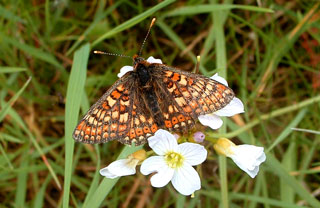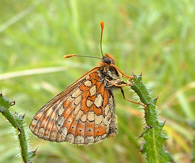BACK TO

Wing Span 1 3/4" ( 45mm )
Marsh Fritillaries are most likely found in Marshes , Bogs and Wet Meadows. It was once called the Greasy Fritillary because of the shiny underside on its forewings or dishclout, likening it to a dirty dish cloth. In times of abundance the principle food plant the Devils Bit Scabious was covered in Balck mats of caterpillars .The young caterpillars survive the winter as a group in a silken ball spiun among the leaves . The Marsh Fritillay has disappeared from the East of England and the Midlands largely due to Land Drainage
This small butterfly is more heavily marked than other fritillaries in the county and is rather more brick-red than orange in general appearance. The Marsh Fritillary was once common and widespread in damp pastures across north Cumbria at least. The caterpillars feed on Devil's-bit Scabious growing in damp, tussocky grassland and agricultural improvement over the last 50 years has led to a huge loss of suitable habitat for the butterfly in Cumbria. The plight of the Marsh Fritillary is worsened by its need to move between a network of sites to avoid the devastating effects of parasitic wasps that attack the caterpillars, so that isolated patches of suitable habitat are often unable to sustain a population of the butterfly long term. In the 1980s just half a dozen or so colonies of Marsh Fritillaries remained in Cumbria. Since then and despite concerted efforts to conserve them, these colonies have died out one by one. In 2004 only two larval webs were found at one site in the county. These have been taken into captivity (under licence) in an attempt to breed up the population and release the butterfly back into the wild.
IMAGE COURTESY OF STEVE SHROUD (C)


